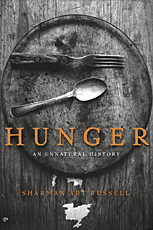Sharman Apt Russell teaches writing at Western New Mexico University and Antioch University in Los Angeles, California. She has excelled in a genre of nonfiction literature which might be called "single-subject" exploration. We read her book Anatomy of a Rose and came away with fresh delight for these flowers. An Obsession with Butterflies gave us a veritable treasure trove of fascinating information about these creatures. In this new volume, Russell takes on a much more serious and arcane subject: hunger and its many manifestations, from "miracle maids" to fasting, hunger artists, starvation of people around the world, hunger strikes, anorexia nervosa, and the protocols of famine.
Some stark contrasts of hunger are found in America where more than 30 million people — one in 10 — live in food-insecure households. Twelve million of these are children, and the numbers are increasing. At the same time, the mass media and a multi-billion dollar diet industry promotes thinness. Young girls who haven't lost their baby fat are sent to fat farms to lose weight while in other parts of the same communities, some of their peers have nothing to eat for dinner.
Meanwhile, fasting has become more popular as a way of giving the body a rest, getting rid of toxins, and achieving greater health. Russell does a fine job assessing fasting in the world religions and is especially impressive in her coverage of hunger strikes, including those by Mahatma Gandhi. She writes: "Hunger is a form of communication. When we fast for health, we are having a conversation with the body. When we fast as a Jew or Catholic, Muslim or Hindu, we are having a conversation with God. These are private discussions and often silent. Hunger strikes are different. Almost always, they are loud and public, like a messy family argument the whole neighborhood can hear. The man or woman fasting for change wants the world to know — and judge. To know — and act. The conversation is with the world."
